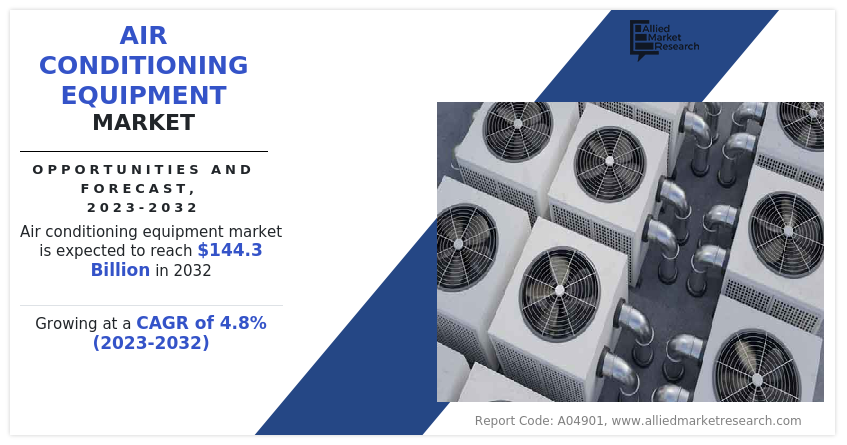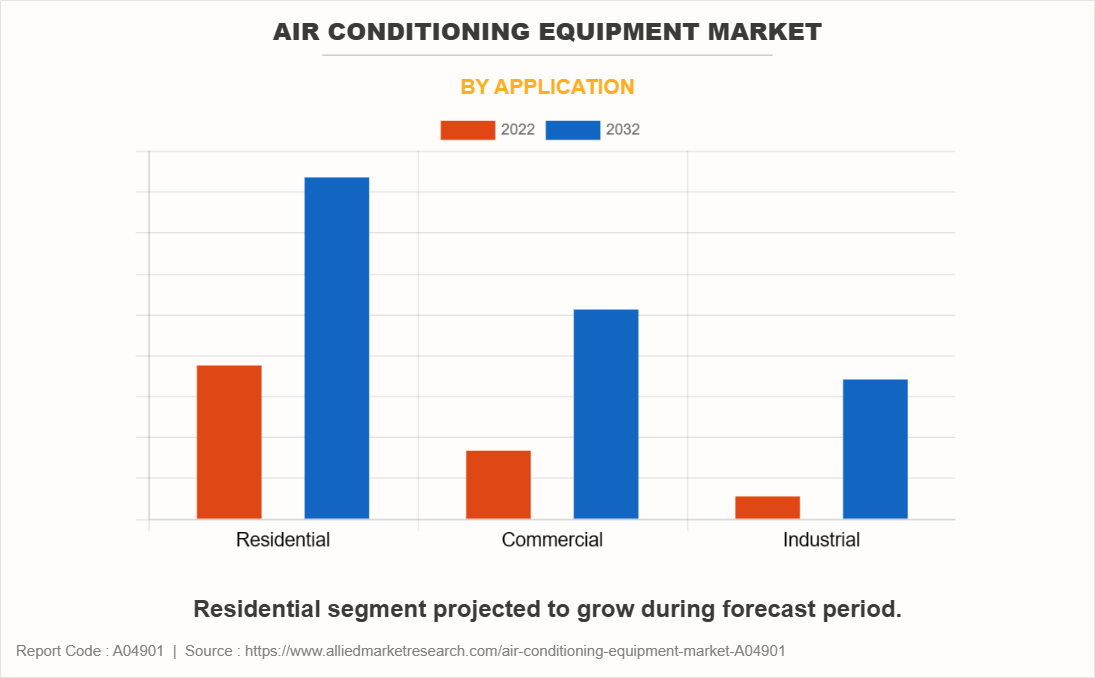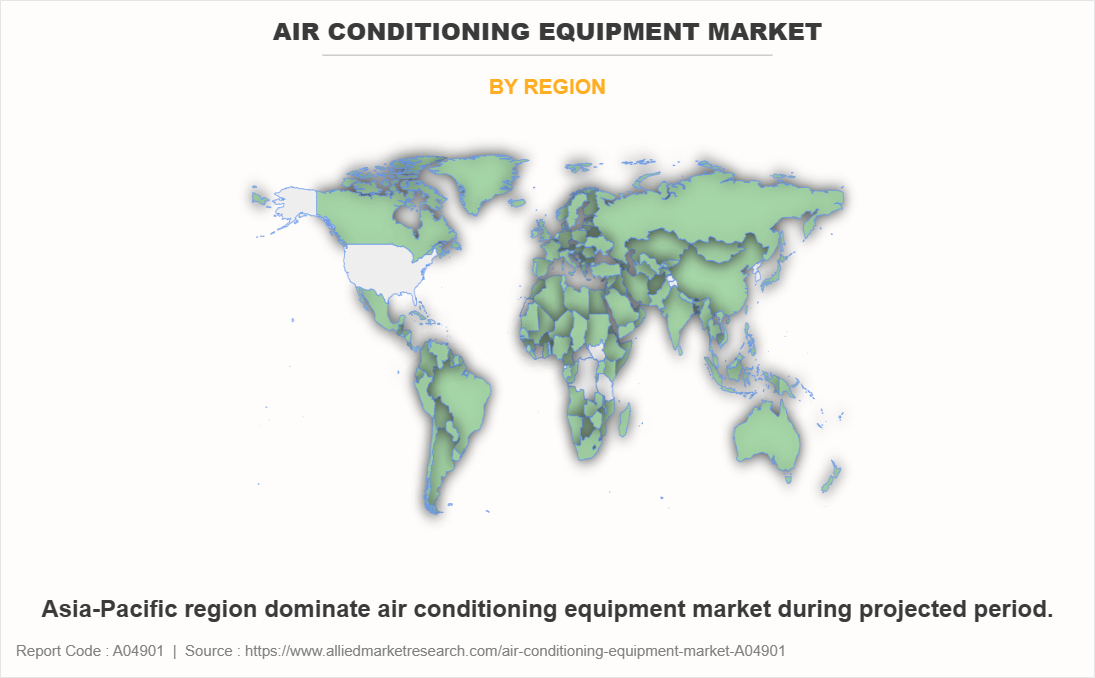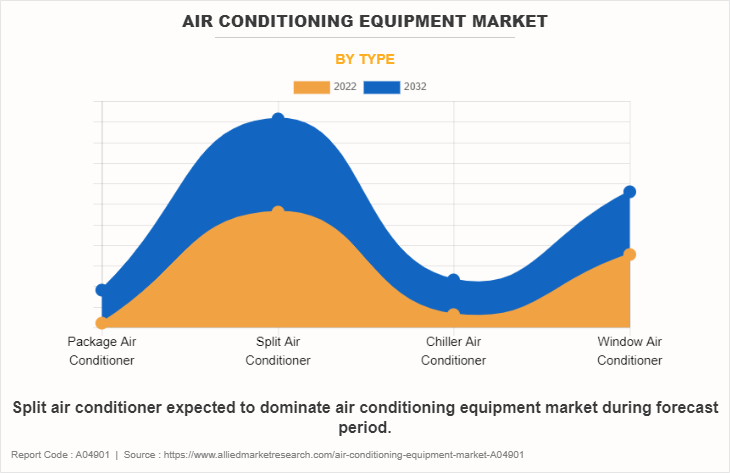Air Conditioning Equipment Market Research, 2032
The global air conditioning equipment market was valued at $89.9 billion in 2022, and is projected to reach $144.3 billion by 2032, growing at a CAGR of 4.8% from 2023 to 2032.

Air conditioning is a process to control and change air temperature, moisture, and cleanness of air in favorable condition. The air conditioning equipment’s not only used for cooling, but also used for heating, ventilation, and air conditioning. The main function of air conditioning equipment is to maintain air temperature inside the building. Air conditioning equipment include package air conditioner, spilt air conditioner, chiller air conditioner, and window air conditioner. They are mainly used in industrial, residential, and automotive applications.
Further, several commercial businesses such as hotels, offices, retail stores, and restaurants, are installing split air conditioning systems with an aim to lower their electricity consumption. Such adoption of split air conditioners in the commercial buildings expected to promote the split air conditioning systems market during the air conditioning equipment market forecast period. Air conditioners (ACs) sold in Japan and the European Union are typically 25% more efficient than those sold in the U.S. and China. In countries such as the U.S. and Japan, more than 90% of households have air conditioning, compared to just 8% of the 2.8 billion people living in the hottest region of the global.
Increase in average global temperatures due to climate change, economic growth and urbanization are widely expected rise demand for cooling. Assessments made by the International Energy Agency forecast that the number of air conditioners in use globally will increase from 1.5 billion to 5.5 billion units between 2015 and 2050. Air conditioner sales are growing at 10–15% per year in hot, populous countries such as Brazil, China, India and Indonesia. Further generate the demand for air conditioning equipment market size.

Development in residential and industrial sector is the major factor that drives the growth of the air conditioning equipment market. The air conditioning equipment offers plenty of benefits such as produce less noise and easy installation. Now a days, there is an increase in the demand for air conditioning equipment owing to rise in urbanization and surge in industrialization specifically in the Asia-Pacific region. However, high cost of air conditioning equipment as well as its installation hamper the air conditioning equipment market growth. Fluctuating prices of raw materials also restrain the overall growth of the market. Technological advancement, which helps to develop new products formulation is expected to offer new growth opportunities to air conditioning equipment market.
The packaged air conditioner market stands as the largest segment within the machinery and equipment industry, exhibiting remarkable and consistent growth. As per Daikin published report, packaged air conditioners expected to grow considerably over the next five years estimated at $17,500 million and 24.5 million units in 2020. The global packaged air conditioner market grows at a CAGR of 5.29 air conditioning equipment market. The residential segment, accounting for more than two-fifths of the global air conditioning equipment market size, and is estimated to maintain its leadership status throughout the forecast period.

The Europe market for air conditioning equipment industry is being driven by factors such as rising construction spending, government investments in green building initiatives, and fast urbanization. Europe is also seeing an increase in cooling demand as salaries and living standards rise. Although the environmental effect of air conditioning is now minor, the ownership and consumption of air conditioners are likely to increase.
In Europe, there is a growing need for fresh air distribution in commercial and industrial organizations to provide safe and healthy indoor workplaces. For instance, in February 2022, Daikin announced the EKVDX-A direct expansion coil module, which is compatible with Daikin's enhanced VAM-J8 decentralized ventilation unit and provides fresh air while lowering the heat load impact on comfort air-conditioning systems. This direct-expanding coil module generates clean, fresh air in commercial and industrial sectors.

Increase use of split air conditioning systems in the Europe market has resulted from growing demand for energy-saving alternatives. Government encourage energy-efficient models further accelerates the replacement of old systems with energy-saving alternatives. In recent years, the power consumption of split air conditioner market has increased significantly. As a result, leading manufacturers are embracing green and cutting-edge technology. The increasing number of residential infrastructure projects, notably in Germany, France, and Russia, is likely to drive market expansion over the forecast period.
For instance, in March 2022, Carrier launched AquaForce Vision 30KAV with PUREtec refrigerant, an R1234ze chiller designed for industrial applications such as pharmaceuticals, food manufacturing, chemicals, plastics, metal industries, and other applications that require ultra-reliable cooling up to -12 degrees Celsius. The split air conditioner segment, accounting for more than two-fifths of the global air conditioning equipment market share in terms of revenue, and is estimated to maintain its leadership status throughout the forecast period.
The air conditioning equipment market scope is segmented on the basis of type, application and region. On the basis of type, it is classified split air conditioner, window air conditioner, chiller air conditioner, and packaged air conditioner. On the basis of application, it is divided into residential, commercial, and industrial. Region wise, the market is studied across North America, Europe, Asia-Pacific, and LAMEA. Presently, Asia-Pacific accounts for the largest share of the market, followed by Europe and North America. The major companies profiled in this report include Hitachi Ltd, Mitsubishi Electric, Panasonic Corporation, Midea Group Co., Ltd., Samsung Electronics, Sharp Corporation, Electrolux AB, LG Electronics, Johnson Controls, and Daikin Industries, Ltd.
Key Benefits For Stakeholders
- This report provides a quantitative analysis of the market segments, current trends, estimations, and dynamics of the air conditioning equipment market analysis from 2022 to 2032 to identify the prevailing air conditioning equipment market opportunities.
- The market research is offered along with information related to key drivers, restraints, and opportunities.
- Porter's five forces analysis highlights the potency of buyers and suppliers to enable stakeholders make profit-oriented business decisions and strengthen their supplier-buyer network.
- In-depth analysis of the air conditioning equipment market segmentation assists to determine the prevailing market opportunities.
- Major countries in each region are mapped according to their revenue contribution to the global market.
- Market player positioning facilitates benchmarking and provides a clear understanding of the present position of the market players.
- The report includes the analysis of the regional as well as global air conditioning equipment market trends, key players, market segments, application areas, and market growth strategies.
Air Conditioning Equipment Market Report Highlights
| Aspects | Details |
| Market Size By 2032 | USD 144.3 billion |
| Growth Rate | CAGR of 4.8% |
| Forecast period | 2022 - 2032 |
| Report Pages | 301 |
| By Type |
|
| By Application |
|
| By Region |
|
| Key Market Players | LG Electronics, Johnson Controls, Electrolux AB, Samsung Electronics, Sharp Corporation, Daikin Industries, Ltd., Midea Group Co., Ltd., Panasonic Corporation, Mitsubishi Electric, Hitachi Ltd |
| Other Key Market Players | MIDEA Group Co. Ltd. , Samsung Electronics Co. Ltd. , Sharp Corporation , Lennox International Inc. |
Analyst Review
According to CXO perspective, the global air conditioning equipment market is expected to witness increased demand during the forecast period due to a rise in residential and commercial construction.?
Increase in urbanization and economic growth has led to the increased construction of shopping malls, hospitals, commercial buildings, hotels, and manufacturing facilities. The expansion of commercial spaces, new office surfaces, corporate centers and special economic zones (SEZs), and organized points of sale drives the demand for air conditioning facilities in all countries.
European Union took various initiatives and introduced projects to reduce energy consumption by air conditioning systems and lower direct emissions. The new solutions are being introduced which are technically feasible and comply with the most stringent European safety standards. For instance, in August 2021, The European Union-funded Life-Zero GWP project developed the first high-efficiency double-ducted propane (R290) air conditioner with no outdoor unit. The new mono-block INNOVA 2.0NR has a compact design along with a reduced energy consumption and lower direct emissions. Each refrigeration circuit uses less than 150g of R290, keeping the units in compliance with European safety standards.
The residential is the leading application of Air Conditioning Equipment Market.
Asia-Pacific is the largest regional market for Air Conditioning Equipment.
The Energy Efficiency, Sustainability and Eco-friendliness, Smart and Connected Systems, Health and IAQ (Indoor Air Quality) and Heat Pumps are the upcoming trends of Air Conditioning Equipment Market in the world.
The estimated industry size of Air Conditioning Equipment is $144.3 billion in 2032.
The top companies to hold the market share in Air Conditioning Equipment Hitachi Ltd, Mitsubishi Electric, Panasonic Corporation, Midea Group Co., Ltd., Samsung Electronics, Sharp Corporation, Electrolux AB, LG Electronics, Johnson Controls, and Daikin Industries, Ltd.
Loading Table Of Content...
Loading Research Methodology...



